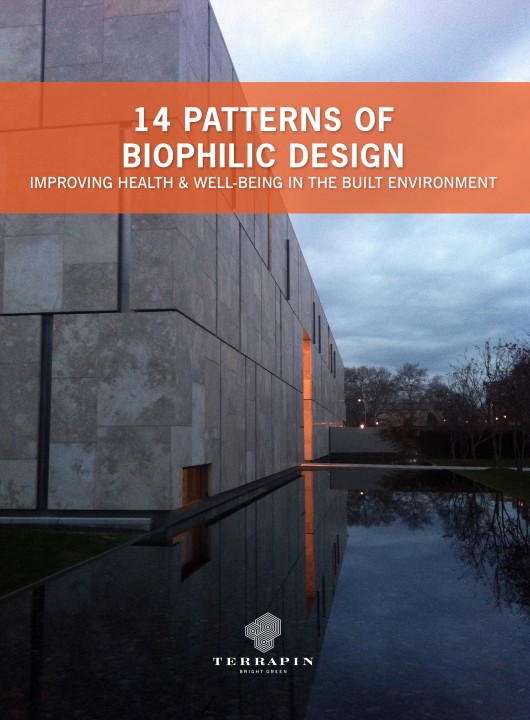Terrapin Report
14 Patterns of Biophilic Design
Improving Health and Well-Being in the Built Environment
Read the report to understand the 14 patterns of biophilic design and how to apply them to improve health and wellbeing in the built environment. Click here to read more about our biophilic design services or contact the Terrapin team to learn more by emailing us at [email protected].
Abstract
Biophilic design can reduce stress, enhance creativity and clarity of thought, improve our well-being and expedite healing; as the world population continues to urbanize, these qualities are ever more important. Theorists, research scientists, and design practitioners have been working for decades to define aspects of nature that most impact our satisfaction with the built environment. “14 Patterns of Biophilic Design” articulates the relationships between nature, human biology and the design of the built environment so that we may experience the human benefits of biophilia in our design applications.
Biophilia in Context looks at the evolution of biophilic design in architecture and planning and presents a framework for relating the human biological science and nature. Design Considerations explores a sampling of factors (e.g., scale, climate, user demographics) that may influence biophilic design decisions to bring greater clarity to why some interventions are replicable and why others may not be. The Patterns lays out a series of tools for understanding design opportunities, including the roots of the science behind each pattern, then metrics, strategies and considerations for how to use each pattern. This paper moves from research on biophilic responses to design application as a way to effectively enhance health and well-being for individuals and society.
Copyright & Commercial Use
This article is available to the general public without fee or other access control. Anyone may read this article or use it for their own personal or academic purposes. No commercial use of any kind is permitted unless specific permission is granted in writing in advance. The copyright of this article is by Terrapin Bright Green, LLC. The copyright of images is by cited photographers.
Suggested Citation
Browning, W.D., Ryan, C.O., & Clancy, J.O. (2014). 14 Patterns of Biophilic Design. New York: Terrapin Bright Green, LLC. https://www.terrapinbrightgreen.com/report/14-patterns/
Translations
14 Patterns of Biophilic Design is available in more than just English! We have partnered with architects, design leaders, and publication houses around the world to be able to share these professional translations. Please contact us if you are able to sponsor another effort that will reach more people through a language that’s not yet represented here.
Books
- English: 14 Patterns of Biophilic Design
- French: 14 Modèles de conception biophilique
- Hebrew: דפוסי תכנון ביופיליים 14
- Italian: I 14 Pattern Della Progettazione Biofilica
- Spanish: 14 Patrones de diseño biofílico
Books coming soon: Chinese
Postcards
- English: 14 Patterns of Biophilic Design
- French: 14 Modèles de conception biophilique
- Hebrew: דפוסי תכנון ביופיליים 14
- Portuguese: 14 Padrões de Design Biofílico
- Spanish: 14 Patrones de diseño biofílico
Postcards coming soon: Chinese, Dutch, Filipino, German
Table of Contents
- Introduction
- Biophilia in Context
2.1 Rediscovering the Intuitively Obvious
2.2 Defining Nature
2.3 Nature-Design Relationships
2.4 Nature-Health Relationships - Biophilic Design Implementation
3.1 What is Good Biophilic Design
3.2 Planning for Implementation
3.3 Locally Appropriate Design
3.4 Design Integration - Design Framework for Biophilic Design
4.1 Nature in the Space
4.2 Natural Analogues
4.3 Nature of the Space - Final Thoughts
- Appendix

